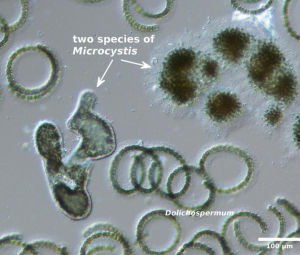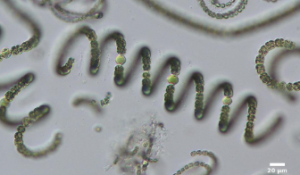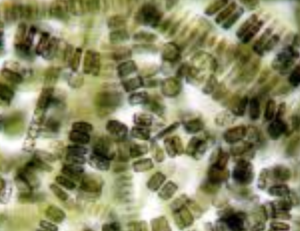42 The Health Risks of Agricultural Runoff: Algal Blooms and Dead Zones
Harmful Algal Blooms (HABs) are becoming a bigger problem, especially in rivers, lakes, and coastal environments.They happen when algae, particularly some species of cyanobacteria and diatoms, grow uncontrollably due to high levels of nutrients in the water. As these blooms develop, they can produce toxins that threaten both ecosystems and human health. (CK)
Cyanobacteria: Microcystis and Dolichospermum
Cyanobacteria, such as Microcystis and Dolichospermum, are known to produce toxins like microcystins that can be harmful to humans. These toxins tend to accumulate during harmful algal blooms in freshwater environments. When people are exposed—whether by drinking contaminated water, swimming in it, or even inhaling water droplets in the air—they can experience a range of health issues. Microcystins primarily target the liver and can cause symptoms like nausea, vomiting, and long-term liver damage. In addition, skin contact may lead to irritation or rashes, and inhalation of aerosols can result in respiratory problems, particularly for individuals with asthma or other lung conditions (Northeast HAB). (CK)


Diatoms (Pseudonitzschia)
Pseudonitzschia is a type of algae that grows in coastal waters, and it produces a harmful toxin called domoic acid. This toxin can build up in shellfish and small fish, and if people eat seafood that has been contaminated, they risk getting Amnesic Shellfish Poisoning (ASP). ASP symptoms can range from nausea and vomiting to confusion and memory problems. In more serious cases, the toxin affects the brain, especially the areas that control memory, causing long-lasting cognitive issues (Washington State Department of Health, n.d.; Lefebvre & Robertson, 2010). (CK)

Contaminated Drinking Water & Seafood:
Harmful algal blooms (HABs) can lead to toxins making their way into both drinking water and seafood, which can cause big problems for human health and the environment. For example, illnesses like cholera and typhoid are often linked to contaminated water (World Health Organization, n.d.). (CK)
Pseudonitzschia thrives in saltwater, particularly along coastal areas, and its effects get worse during algae blooms. When these blooms happen, the concentration of domoic acid in the water goes up, making it even more important to monitor these events closely so the toxin doesn’t end up in the seafood people consume. (CK)
